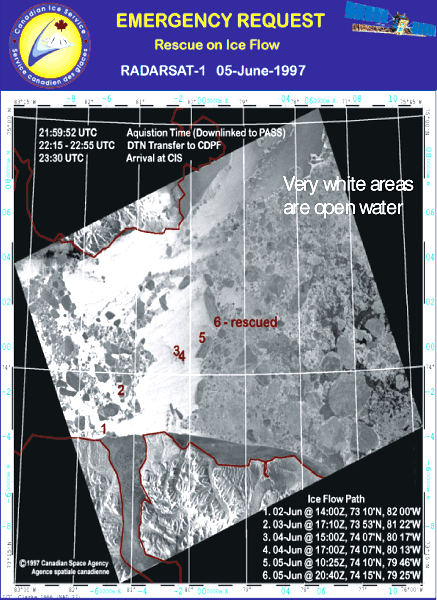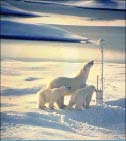Proactive disclosure
Print version   |  | 
Natural Resources Canada > Earth Sciences Sector > Priorities > Climate Change Impacts and Adaptation > Climate Change in Canada
Degrees of Variation : Climate change in Nunavut Of ice and men
The two sides of ice...

Norwegian Bay: Convoy to Eureka
(Canadian Ice Service) |
In the North, sea ice is a fact of life. It can affect shipping and the resupply of isolated communities; however, many traditional northern activities, such as travel, hunting, and fishing, depend on its presence.
Marine transportation...

Northwest Passage
(© 2000, The Living Earth Inc.) |
Less ice in the North would make access to communities easier and create longer shipping seasons. Climate models also suggest the opening of the 'Northwest Passage' is likely. This could see the Arctic become a major international shipping route. More marine traffic could benefit many northern communities and industries, but it could also create social change, increase environmental hazards, and raise sovereignty issues.
Traditional lifestyles...

(D.G. Hodgson, GSC 2000-056A) |
Early break-up or complete loss of ice would have a profound effect on northern life. Adaptation has always been a way of life in the North, however, the rate at which changes are predicted to occur could make adaptation even more challenging in the future.
News North - April 5, 1999
Arctic Turns Tropic?
"Years ago, we used to travel by dog team in the middle of July over the ice but now, by July, people are boating." - Kugluktuk
Traditional knowledge...
Traditional knowledge is used to predict ice conditions and guide hunters in travel and work at the floe edge. Changes in fast ice behavior, such as unusually early break-up, have made predicting ice conditions more difficult and caused dangerous situations in recent years, like the incident of June 1997.

Satellite imagery tracks ice flow
where students drifted for 6 days.
(Canadian Ice Service) |
Nunatsiaq News - June 13, 1997
Stranded Students Safe and Sound After Ordeal
Wildlife...

Shore polynya on Jones Sound
(Canadian Ice Service) |
Polynyas and ice edges are important for northern waters. They serve as feeding, mating, spawning, and overwintering grounds for many marine birds and mammals. The amount of plankton in these areas also means that fish populations thrive. The fate of these polynyas in a warmer climate is currently being studied.
Nunatsiaq News - June 4, 1999
Get Ready Shippers - Sealift's A Month Early This Year
Did you know?
Polynyas are areas of open water surrounded by sea ice. They often form in the same place each winter.
Research...

Momma has her own idea of the perfect instrument configuration for this buoy.
(© Donald G. Barton, 1992) |
Sea ice provides a platform for monitoring change in the Arctic and for studying the interaction of climate, sea ice, and the marine ecosystem. The International Arctic Buoy Program (http://iabp.apl. washington.edu) provides real time and climate data from the remote regions of the Arctic Basin.
|
